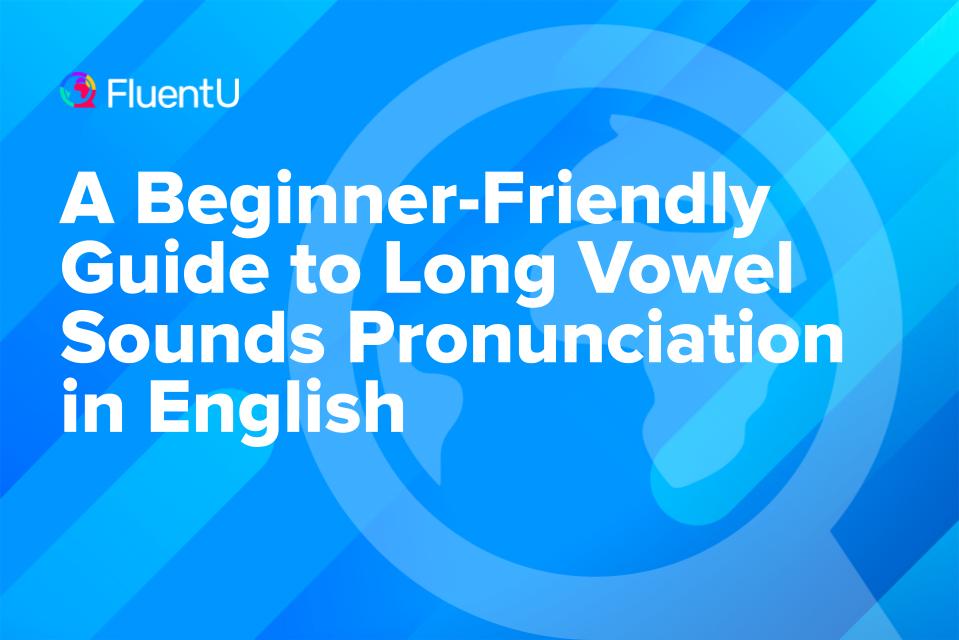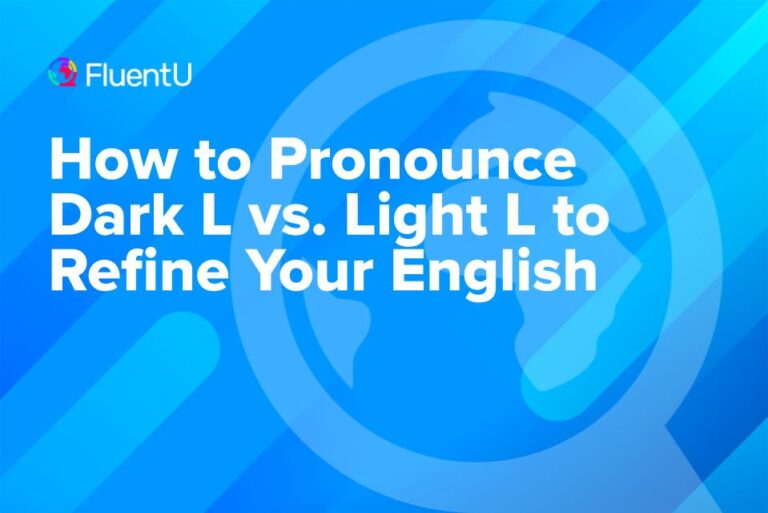A Beginner-Friendly Guide to Long Vowel Sounds Pronunciation in English

Have you ever noticed that one extra letter can make the pronunciation of a word very different in English?
“Hop” doesn’t rhyme with “hope,” even if their spelling is nearly the same. “Got” doesn’t rhyme with “goat,” either, and the same goes for “not” and “note.”
All of these words have the letter O, but they don’t pronounce it in the same way.
This is because there are two main versions of O that you’ll hear in English: the long O and the short O. In this example, “not” has a short O, while “note” has a long O.
All of the vowels have short and long versions – and knowing how to pronounce both is crucial to being understood.
For this blog post, we’ll go over the long vowel sounds pronunciation for all of the vowels in English: A, E, I, O, and U. Hint: if you can sing the alphabet song in your head, you already have an idea of how long vowels sound like!
Download: This blog post is available as a convenient and portable PDF that you can take anywhere. Click here to get a copy. (Download)
Getting to Know Vowels
Traditionally, the English alphabet has five vowels out of its 26 letters: A, E, I, O, and U. On top of these, Y and W are sometimes considered as vowels when they’re pronounced respectively as /ee/ and /oo/.
Although this might seem like a small number, vowels can be incredibly flexible. All in all, they form more than ten different sounds, depending on where they are in the word and which letters come after them!
Each vowel in English has at least three possible sounds:
- Long
- Short
- Silent
A common pronunciation mistake for non-native English speakers is to mix up the vowel sounds for the same letter. Since vowels are practically at the heart of every word in English, this makes sentences difficult to understand, and you might even sound like you’re saying something else completely!
What are Long Vowels?
Compared to short vowels, long vowels are usually the easiest for English learners to pick up. You might be aware of all of them already without realizing it!
When you recite the vowels in the alphabet, you’re already pronouncing them the long vowel way. To be specific:
- Long A sounds like /EI/ (“name”)
- Long E sounds like /EE/ (“eager”)
- Long I sounds like /AI/ (“title”)
- Long O sounds like /OU/ (“goat”)
- Long U sounds like /YOO/ (“universe”)
What sets long vowels apart from short vowels is that you’re moving around your mouth a lot more (and pronouncing them for longer).
For example, the letter O in “goat” is a long vowel, and it’s pronounced as /OU/. However, the letter O in “got” is a short vowel. This time, you pronounce it simply as /O/.
With short vowels, the sound naturally ends earlier, and you’re putting in less force or effort with your mouth.
A Guide to Long Vowel Sounds Pronunciation
All of the long vowels can be broken down into two sounds. The key to pronouncing them is to shift smoothly from one sound to another – this can happen in as fast as a split second during conversation!
Let’s dive into how to pronounce the long vowels in English:
Long A
Sound: /EI/
Keyword: Day /dei/
The long A is made up of two sounds: regular E (/eh/) and I (/ee/). If you can pronounce both separately, all you have to do is to link them together – and you already have the long A.
Start by positioning your mouth to say the letter E. Your mouth should be relaxed and slightly open. As you switch to the I sound (/ee/), lift your tongue up until the sides are touching your front teeth. Widen your mouth almost as if you’re smiling. At this point, your mouth will be more tense compared to when you started.
Examples:
- Brave /breiv/
○ The lead characters in fairy tales are often brave.
- Gate /geit/
○ The gate was closed when I went there.
- Nail /neil/
○ We’re going to try to remove the nail from the wall.
- Rain /rein/
○ It’s cozy this morning because of the rain.
- Ray /rei/
○ Try to capture that ray of sunlight in your photo.
Long E
Sound: /EE/
Keyword: Feet /feet/
To pronounce the long E, widen the corners of your mouth a little. Then press your tongue up so it’s nearly pressed against the roof of your mouth, with the tip angled down and forward. Keep your teeth apart, and make sure your jaw’s dropping slightly. You should feel some tension in your mouth and face!
Out of all the sounds in English, the long E is the sound that puts the tongue closest to the top of your mouth.
Examples:
- Cheese /cheez/
○ We have to use up all of the cheese in the fridge.
- Deer /deer/
○ I spotted a deer over at the park.
- Key /kee/
○ She left her key behind at work.
- Knee /nee/
○ The football player had to take a break because of a knee injury.
- Queen /kween/
○ Everyone’s so excited to talk to the queen.
Long I
Sound: /AI/
Keyword: Light /lait/
For the long I, you’ll be pronouncing A first (/ah/) followed by EE. Put more emphasis on A, and make the EE shorter.
To start, open your mouth and keep your tongue flat at the bottom. Then say “A” out loud while your lips are relaxed. As you move to the EE sound, both your mouth and tongue will shift positions. Widen your mouth while closing your jaw a little, then lift your tongue closer to the top of your mouth. Your tongue should be brushing against the sides of your front teeth as you say “EE.”
Examples:
- Bride /braid/
○ The bride is really happy with the flowers.
- High /hai/
○ He can’t reach the book because it’s too high up on the shelf.
- Ice /ais/
○ This drink tastes better with lots of ice.
- Like /laik/
○ What did you like about the movie?
- Pie /pai/
○ We’re serving apple pie at the party later.
Long O
Sound: /OU/
Keyword: Home /houm/
Most languages have an O sound, but they might pronounce differently from the long O in English, which is made up of a short O followed by a short U sound.
For the first part of the sound, round your lips and tense them up. Keep your tongue lower in your mouth, then say the short O sound. Then pronounce U by moving your lips closer together into a tight circle.
Examples:
- Cone /koun/
○ This is my favorite type of ice cream cone.
- Go /gou/
○ She invited us to go jogging if we wake up early.
- Loan /loun/
○ He’s thinking of getting a loan because he’s buying another apartment.
- Note /nout/
○ Can you write your request on the note?
- Vote /vout/
○ They’ve reached more than a thousand votes now.
Long U
Sound: /YU/
Keyword: Music /myoozik/
A simple way to think of the long U is to imagine that the word has the letter Y inserted into it right before the U. For example, “music” is actually more like /myoozik/.
The long U has two parts: the Y sound followed by U. For the Y sound, open your mouth slightly and push your tongue forward near the top of your front teeth while saying the sound. When you shift to the U sound, form a small circle with your lips, then lower the front of your tongue as the back remains high.
Examples:
- Cube /kyoob/
○ You can find a jar of sugar cubes in the kitchen.
- Cute /kyoot/
○ Those puppies are incredibly cute!
- Huge /hyooj or yooj/
○ That huge tree in the distance is over a hundred years old.
- Mute /myoot/
○ We can’t hear you because you’re on mute.
- Use /yooz/
○ Which app on your phone do you use the most?
Conclusion
Despite their name, long vowels aren’t only a longer version of short vowels – they have their own unique pronunciation. Hopefully, after reading through this pronunciation guide, you have a much better idea of how to say each long vowel out loud.







